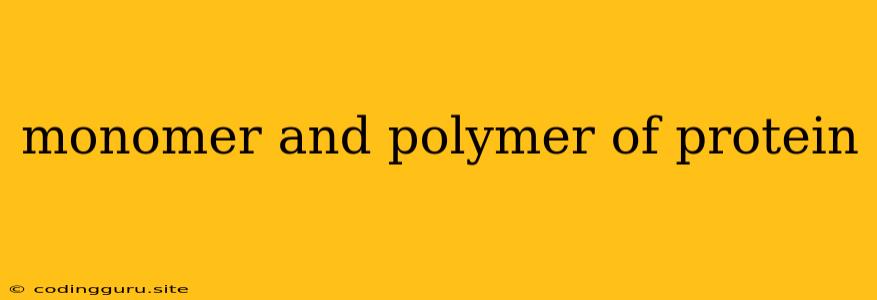Delving into the Building Blocks of Life: Monomers and Polymers of Protein
Proteins are essential molecules that play a crucial role in virtually every biological process. From the structure of our cells to the regulation of our metabolism, proteins are the workhorses of life. But what exactly are proteins, and how are they built? The answer lies in understanding the relationship between monomers and polymers.
What are Monomers and Polymers?
Monomers are small, simple molecules that serve as the building blocks for larger, more complex molecules called polymers. Think of monomers as LEGO bricks – individual pieces that can be assembled into various structures.
In the context of proteins, the monomer is an amino acid. Amino acids are organic molecules that contain a central carbon atom bonded to four different groups:
- An amino group (NH2)
- A carboxyl group (COOH)
- A hydrogen atom (H)
- A side chain (R group)
The R group is what differentiates one amino acid from another. There are 20 different amino acids, each with a unique R group that imparts specific chemical properties.
From Amino Acids to Proteins: The Polymerization Process
Now, imagine joining these LEGO bricks together to form a larger structure. This is exactly what happens when amino acids link up to form a polymer, which in this case is a protein. The process of joining monomers to form polymers is called polymerization.
In the case of proteins, the polymerization process involves the formation of peptide bonds. Peptide bonds are strong covalent bonds that form between the carboxyl group of one amino acid and the amino group of another. This process releases a molecule of water.
As amino acids join together one by one, a polypeptide chain is formed. A polypeptide chain is simply a linear sequence of amino acids linked by peptide bonds.
From Polypeptide Chain to Functional Protein: The Importance of Structure
It's important to note that a polypeptide chain is not yet a functional protein. A functional protein needs to fold into a specific three-dimensional structure. This folding is determined by the sequence of amino acids in the chain and is influenced by various factors like hydrogen bonding, hydrophobic interactions, and ionic interactions.
The three-dimensional structure of a protein is critical for its function. This structure allows the protein to interact with other molecules in a specific way, enabling it to carry out its biological role.
The Diversity of Proteins: A World of Structures and Functions
The diversity of proteins is truly remarkable. There are countless different proteins, each with a unique structure and function. Some proteins act as enzymes, catalyzing biochemical reactions. Others serve as structural components of cells and tissues. Still, others act as messengers, transmitting signals within the body.
This incredible diversity stems from the different combinations of amino acids that can be used to build polypeptide chains. The number of possible protein sequences is virtually limitless, allowing for a vast array of structures and functions.
Exploring the World of Proteins: Tools and Techniques
Scientists use various techniques to study the structure and function of proteins.
- X-ray crystallography is a powerful technique that allows researchers to determine the three-dimensional structure of proteins.
- Mass spectrometry can be used to identify and quantify different proteins in a sample.
- Bioinformatics uses computational tools to analyze protein sequences and structures, allowing researchers to predict protein function and identify potential drug targets.
Understanding the Basics of Proteins: A Foundation for Further Exploration
Understanding the relationship between monomers and polymers is essential for comprehending the structure and function of proteins. By recognizing the role of amino acids in forming polypeptide chains, we can begin to appreciate the vast diversity and importance of these essential molecules in life. This foundational knowledge paves the way for further exploration into the fascinating world of proteins and their intricate roles in living organisms.
Conclusion
Proteins are fundamental building blocks of life, constructed from monomers called amino acids joined together to form polymers called proteins. These polymers are not just simple chains; they fold into intricate three-dimensional structures that enable them to perform a wide variety of essential functions. Understanding the relationship between monomers and polymers in the context of proteins is key to unlocking the secrets of life's complex machinery.
